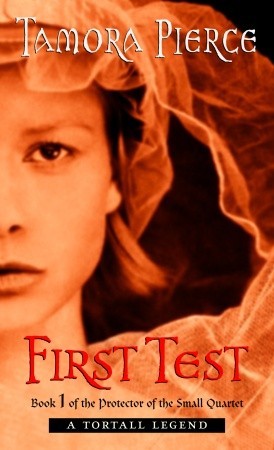When a Book Fails

Not every book is going to be a winner and not every story will grab hold of a reader's attention. Back when I used to teach whole class novels, this used to be a problem that fell squarely on the shoulders of the reader. Don't like a book? Too bad; now plod through the next few weeks of the novel study.
Now that I teach literature circles and book clubs, this is rarely a problem. I don't keep reading a book if I dislike it, so why should I expect students? Students are free to abandon books if it is going to help them find a better read. However, now I am caught with the dilemma of what to do if a title is consistently abandoned.
First Test by Tamora Pierce is one such book. I find this personally disappointing, since I voraciously read Pierce's books in middle school and I expected it to be more popular. It tells the story of Keladry, a girl who wants to become a knight in the fantasy kingdom of Tortall. I figured it would be a good addition to a literature circle about heroic journeys.
A few students do gravitate to it. Those who love it quickly find other copies of Pierce's books on my shelves and work their way through the series. However, it has not been gripping most of my class. A couple of students picked it up, but abandoned it after a few days complaining that they couldn't follow the story or the unfamiliar vocabulary. As an introduction to the fantasy genre, it wasn't doing the job.
Most students just weren't selecting the book to begin with. Near the end of the unit, I asked my class why they weren't choosing it and the overwhelming response was they didn't like the cover. They didn't like the face on it. One group said it was creepy. The other group contrasted it to the other more exciting looking covers. Clearly my book talk at the beginning of the unit needs some improvement. I need to do a better job of selling the book, so students don't solely judge the book by its cover.
More problematic is the fact that First Test is one of only two books with a female protagonist on offer in the unit, the other being the highly popular graphic novel Nimona. Are my students avoiding it because they don't want to read the story of a girl overcoming obstacles and discrimination to succeed in a male dominated field? Why are other novels featuring stories of teen boys overcoming their anger issues striking so much more of a chord?
I don't think that my students are avoiding female protagonists on purpose, but there are some problems with the way the book is marketed. The other covers show protagonists who are in the midst of an adventure. They are climbing mountains, hiking in desolate locations, even facing off against a bear. The cover for First Test doesn't really indicate what the book is about, nor is it exciting. A slightly worried looking girl gazes out at the reader, wrapped in what looks like a shawl. It does a disservice to the book, neither showing Keladry's tenacity or courage. I'm curious why the publisher chose such a cover, when other male protagonists get more dynamic visuals. Interestingly, they seem to have gotten the point, since the newer cover of First Test displays a chainmailed, tougher, and grittier looking Keladry. I'm curious how the book would have fared if students saw that image instead.
While the boy-centered stories in my unit are important, particularly as they focus on challenging cultural norms of anger and aggression, the unit needs to include better female representation. The students of my class need to see female characters struggling to overcome obstacles and succeeding, demonstrating courage and perseverance, and going beyond the damsel in distress cliché. I'm not quite ready to give up on First Test, since the character of Keladry is a valuable example of how a girl can stand up for herself and persevere. Next time I teach the unit, I may wrap up the cover or even replace it with the newer version, to see if that encourages students to give it a try. As well, I need to improve my book talk and better introduce students to the fantasy genre in general. At the same time, I aim to be on the look out for other books with female protagonists who are powerful heroes. All students need to see that girls can be as powerful as any male character, and more books and other media with that message are essential.


